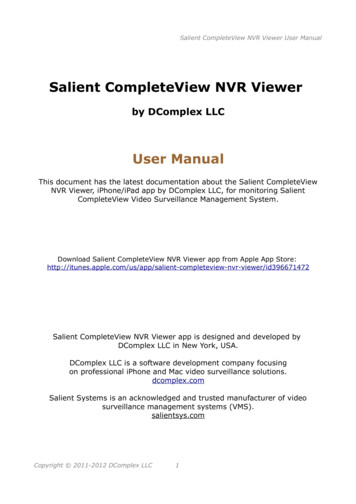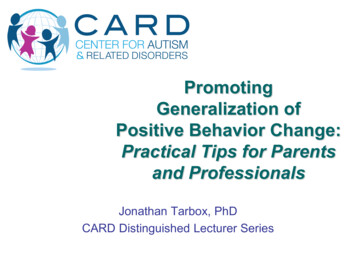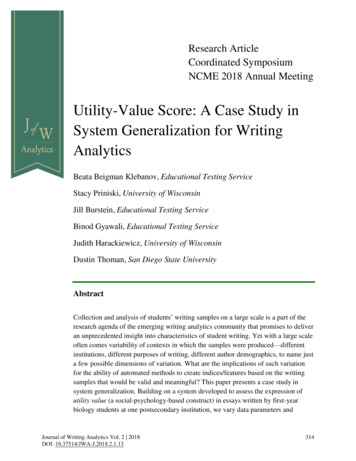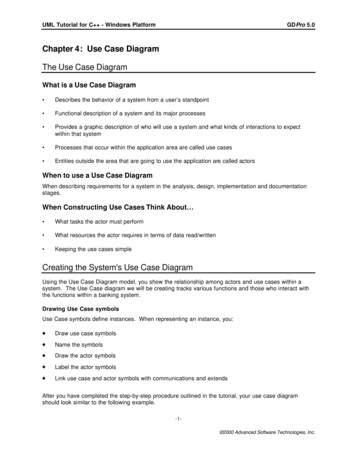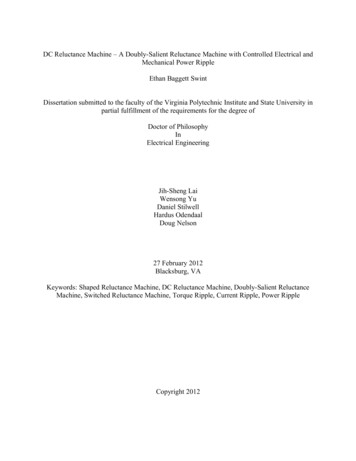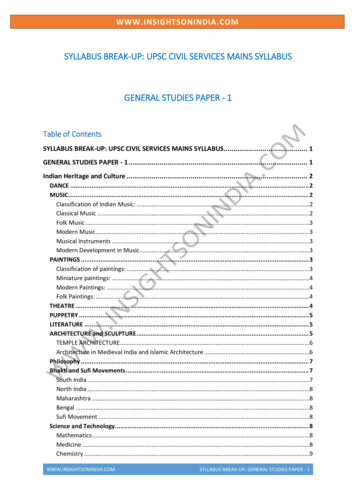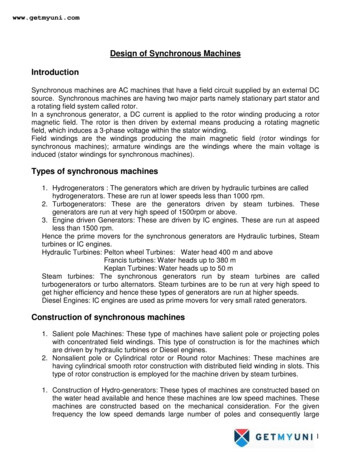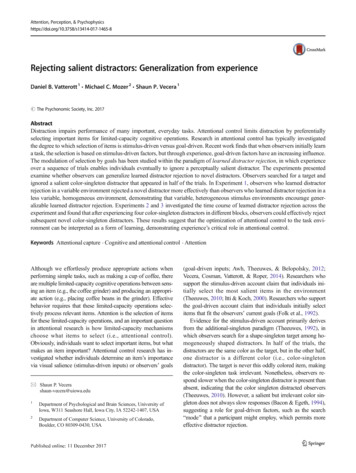
Transcription
Attention, Perception, & 65-8Rejecting salient distractors: Generalization from experienceDaniel B. Vatterott 1 & Michael C. Mozer 2 & Shaun P. Vecera 1# The Psychonomic Society, Inc. 2017AbstractDistraction impairs performance of many important, everyday tasks. Attentional control limits distraction by preferentiallyselecting important items for limited-capacity cognitive operations. Research in attentional control has typically investigatedthe degree to which selection of items is stimulus-driven versus goal-driven. Recent work finds that when observers initially learna task, the selection is based on stimulus-driven factors, but through experience, goal-driven factors have an increasing influence.The modulation of selection by goals has been studied within the paradigm of learned distractor rejection, in which experienceover a sequence of trials enables individuals eventually to ignore a perceptually salient distractor. The experiments presentedexamine whether observers can generalize learned distractor rejection to novel distractors. Observers searched for a target andignored a salient color-singleton distractor that appeared in half of the trials. In Experiment 1, observers who learned distractorrejection in a variable environment rejected a novel distractor more effectively than observers who learned distractor rejection in aless variable, homogeneous environment, demonstrating that variable, heterogeneous stimulus environments encourage generalizable learned distractor rejection. Experiments 2 and 3 investigated the time course of learned distractor rejection across theexperiment and found that after experiencing four color-singleton distractors in different blocks, observers could effectively rejectsubsequent novel color-singleton distractors. These results suggest that the optimization of attentional control to the task environment can be interpreted as a form of learning, demonstrating experience’s critical role in attentional control.Keywords Attentional capture . Cognitive and attentional control . AttentionAlthough we effortlessly produce appropriate actions whenperforming simple tasks, such as making a cup of coffee, thereare multiple limited-capacity cognitive operations between sensing an item (e.g., the coffee grinder) and producing an appropriate action (e.g., placing coffee beans in the grinder). Effectivebehavior requires that these limited-capacity operations selectively process relevant items. Attention is the selection of itemsfor these limited-capacity operations, and an important questionin attentional research is how limited-capacity mechanismschoose what items to select (i.e., attentional control).Obviously, individuals want to select important items, but whatmakes an item important? Attentional control research has investigated whether individuals determine an item’s importancevia visual salience (stimulus-driven inputs) or observers’ goals* Shaun P. Vecerashaun-vecera@uiowa.edu1Department of Psychological and Brain Sciences, University ofIowa, W311 Seashore Hall, Iowa City, IA 52242-1407, USA2Department of Computer Science, University of Colorado,Boulder, CO 80309-0430, USA(goal-driven inputs; Awh, Theeuwes, & Belopolsky, 2012;Vecera, Cosman, Vatterott, & Roper, 2014). Researchers whosupport the stimulus-driven account claim that individuals initially select the most salient items in the environment(Theeuwes, 2010; Itti & Koch, 2000). Researchers who supportthe goal-driven account claim that individuals initially selectitems that fit the observers’ current goals (Folk et al., 1992).Evidence for the stimulus-driven account primarily derivesfrom the additional-singleton paradigm (Theeuwes, 1992), inwhich observers search for a shape-singleton target among homogeneously shaped distractors. In half of the trials, thedistractors are the same color as the target, but in the other half,one distractor is a different color (i.e., color-singletondistractor). The target is never this oddly colored item, makingthe color-singleton task irrelevant. Nonetheless, observers respond slower when the color-singleton distractor is present thanabsent, indicating that the color singleton distracted observers(Theeuwes, 2010). However, a salient but irrelevant color singleton does not always slow responses (Bacon & Egeth, 1994),suggesting a role for goal-driven factors, such as the searchBmode that a participant might employ, which permits moreeffective distractor rejection.
Atten Percept PsychophysAlthough researchers typically portray attentional controlas an immutable system using either stimulus-driven or goaldriven inputs, recent accounts have emphasized the interplayof stimulus-driven and goal-relevant factors (Gaspelin,Leonard, & Luck, 2015, 2017). One factor that appears tointegrate stimulus- and goal-driven factors is the role that experience plays in the balancing between these inputs (Awhet al., 2012; Vecera et al., 2014). For example, individualsselect targets sooner if the targets appear in a consistent, predictable configuration with distractors, an effect termed contextual cuing (Chun, 2000; Chun & Jiang, 1998). More immediate experience also affects attention: targets are discriminated quicker when preceded by a similar target than a dissimilar target, as in priming of pop out (Maljkovic &Nakayama, 1994, 1996, 2000; Kristjánsson & Campana,2010). The foregoing examples center on how experience influences target localization and discrimination; however, effective attentional selection also requires one to rejectdistracting information and objects.Experience appears to affect distractor rejection. For instance,Leber and Egeth (2006) trained observers with displays thateither encouraged observers to search specifically for the target(i.e., feature-search mode; Bacon & Egeth, 1994) or generallyfor unique items (i.e., singleton-detection mode; Pashler 1988).All observers then completed a test phase with displays, termedBoption trials, in which search could be deployed in eitherfeature-search mode or singleton-search mode. Leber andEgeth (2006) found that color singletons during the option trialsdid not distract observers if the observers previously trained withdisplays that encouraged them to search for a specific target.Color singletons during the option trials did distract observersif the observers previously trained with displays that encouragedthem to search for unique items. Thus, past experience using anonspecific, singleton search strategy made observers susceptible to distraction.Vatterott and Vecera (2012) investigated the role of distractorrejection experience on attentional control. Observers beganwith a training block that encouraged a precise search strategy,searching for a target shape (e.g., circle) among heterogeneouslyshaped distractors (triangles, diamonds, and squares). Duringthis training phase, color-singleton distractors never appeared.Following the training phase, blocks of trials were presented inwhich a color-singleton distractor appeared in 50% of the trials.Importantly, the color of the singleton distractor changed eachblock. Varying the distractor color allowed Vatterott and Vecera(2012) to distinguish among three alternative mechanisms ofattentional control. If search strategy alone was sufficient toreject color-singleton distractors, then the color singletonsshould never distract individuals. Alternatively, observers mightneed general experience rejecting any salient distractor. In thiscase, color singletons in the early part of the first block distractobservers, because they are novel, but observers learn to rejectthem (say, in the second half of the first test block) and theneffectively reject all following color-singleton distractors.Finally, observers might require experience rejecting each distinct color singleton to reject other singletons of the same color.In this scenario, each time the color of the singleton changes, thecolor-singleton distract observers in the early part of each blockbefore observers have sufficient experience to reject it. Vatterottand Vecera (2012) found support for the final hypothesis: Evenwhen observers use feature-search mode, they must experienceeach color singleton to learn to reject them effectively. Theseresults suggest that observers learn to reject distractors throughitem-specific experience. We refer to this item-specific learningas learned distractor rejection.Recent research demonstrated that attentional control constantly adjusts to the environment (Cosman & Vecera, 2014;Leber & Egeth, 2006; Vatterott & Vecera, 2012), but little isknown about how attentional learning compares to other typesof learning. Vatterott and Vecera (2012) demonstrated that atleast one type of attentional learning—learned distractor rejection—is item-specific. Other forms of learning, such asskill learning, often exhibit high specificity, but this learninggeneralizes under the right circumstances, for example, whenpractice is variable (Schmidt & Bjork, 1992). The experimentsin this article examined whether observers can generalizelearned distractor rejection. We first investigated whether variable practice encourages generalization of learned distractorrejection. Previously, we found evidence that learneddistractor rejection was item-specific when the salientdistractors appeared in a blocked manner (Vatterott &Vecera, 2012). We asked if a more variable, heterogeneousdistractor environment could produce a distractor rejectionstrategy that generalized to novel items.Previous research in a variety of domains has demonstratedthat variable environments help individuals to generalizelearning more effectively to novel environments (Schmidt &Bjork, 1992). For example, practicing bean bag tossing at avariable-distance target produces more accurate tosses duringa testing phase than does practicing on a fixed-distance target(Kerr & Booth, 1978). In a perceptual coincident timing task,Catalano and Kleiner (1984) sat observers in front of lightsthat illuminated in succession to create the perception of anobject moving toward the observer at a constant rate.Observers responded when the light closest to the observerlit. In test trials, observers who were trained with variableapproach speeds generalized better to novel-approach speedsthan observers trained with constant-approach speeds. Thebenefits of variable practice extend to speech perception:When learning to discriminate the English phonemes /l/ and/r/, native Japanese participants were better able to generalizeto new English speakers when those participants had heard thephonemes produced by varied speakers, suggesting that variability in phoneme production across speakers allowed phoneme discrimination to generalize more effectively to a newtalker (Lively, et al., 1993). Similarly, category formation is
Atten Percept Psychophysinfluenced by the variability of category members. When category members were highly variable during category learning,participants’ transfer to new stimuli was better than if categorymembers were less variable (Homa & Vosburgh, 1976).The current experiments test whether a heterogeneousenvironment is better suited than a homogeneous environment for training observers to reject novel distractors. Iflearned distractor rejection uses domain general learningmechanisms similar to other types of learning, a variable,heterogeneous distractor environment might enable observers to reject novel distractors without previouslyexperiencing these specific distractors.The following experiments are largely modeled afterVatterott and Vecera (2012), with some key exceptions. InExperiment 1, half of the observers experienced a heterogeneous stimulus environment in which three different colorsingletons appeared interspersed throughout three blocks(Mixed group). The other half of observers experienced a homogeneous stimulus environment in which a different singleton color appeared in each of three blocks (Blocked group)and is constant within the block, replicating Vatterott andVecera (2012). As in our previous experiments (Vatterott &Vecera, 2012), in Experiment 1 we analyzed the Blockedgroup by collapsing across trials within a training block.This procedure increases the number of trials for analysis,allowing us to examine the effect of a novel distractor whenit appears at the beginning of a block of trials versus at the endof that block. Such collapsing is not possible in the mixedblocks, because all distractor colors appear throughout, sowe analyzed these trials by each individual training block.Both the Blocked group and the Mixed group were thentested with a novel distractor color in a final block of trials; thisfinal block always contained a single distractor color, whichappeared in half of the trials. This test block provided the criticaltest of training variability, because this final block was identicalfor both the Blocked and Mixed groups. If learned distractorrejection is better generalized following variable training thanfixed training, then a novel color singleton in the fourth blockwill initially distract observers in the Blocked group, but it maynot distract observers in the Mixed group. If learned distractorrejection is completely item-specific and shows no tendency togeneralize, then the novel color singleton will initially distractobservers in both groups.Experiment 1MethodsParticipants Thirty-seven University of Iowa undergraduatescompleted the experiment for partial course credit. All reported normal or corrected-to-normal vision.Apparatus A Macintosh Mini computer using MATLAB andthe Psychophysics Toolbox (Brainard, 1997) collected responses and presented the stimuli on a 17-in. CRT display.Observers sat approximately 60 cm from the display.Stimuli and procedure Six colored shapes equally spacedaround the circumference of an imaginary circle centered atfixation with a radius of 4.2 composed the displays. Fixationwas a small white circle in the center of the screen. Each shapewas roughly 2.5 square and contained a randomly verticallyor horizontally oriented line (0.7 1 ). The stimuli consistedof a target (circle) and five distractors (triangle, diamond, orsquare). The target position was chosen pseudo-randomly oneach trial. The identity of each distractor was chosen pseudorandomly on each trial, with the only constraint being that thedistractors were not all the same identity. The target and alldistractors were green (RGB 0, 255, 0) except on singletonpresent trials when one distractor was either red (RGB 255, 0,0), yellow (RGB 255, 255, 0), purple (RGB 255, 0, 255), ororange (RGB 255, 150, 0).1 The color-singleton position waschosen randomly from among the distractors on each trial.Each trial began with only the fixation point visible for1,000 ms followed by the search display for 5,000 ms or untilresponse. If an observer failed to respond within 5,000 ms, theobserver was encouraged to respond faster and the trial wasmarked as incorrect. A beep informed observers of incorrectresponses.Observers pressed either the Bz or Bm key to indicate theorientation of the line within the target green circle. Key binding was counter-balanced across observers. The orientation ofthe line within the circle was chosen pseudo-randomly oneach trial. Observers were instructed to respond as quicklyand accurately as possible and that a differently colored itemmight appear on some of the trials, but this item would neverbe the target, so they should do their best to ignore it. Eyemovements were not monitored, but observers were encouraged to maintain fixation.All observers started the experiment with a 60-trial trainingblock in which observers searched for the target circle amongheterogeneously shaped green distractors. Following the training block, all observers completed 4 test blocks of 48 trialseach. One of the distractors was differently colored (i.e., acolor singleton) in 50% of the trials. The color of the colorsingleton remained the same throughout an entire test blockbut changed between blocks in the Blocked group. See the left1Our stimuli were not equiluminant, which often is the case in studies ofattentional capture. Our distractor colors were chosen to produce similaramounts of distraction, and preliminary analyses of data from many of ourexperiments finds that the different distractor colors produce qualitatively similar results, namely, more distraction when they are first encountered andeffective distractor rejection after those distractors have been encountered forseveral dozen trials (Vatterott, 2015). Most important, we counterbalancedcolor and block to ensure that experience effects are not attributable to specificdistractor colors.
Atten Percept Psychophyspanel of Fig. 1 for a depiction of this procedure. The samethree-colored color singletons appeared intermixed in the firstthree blocks in the Mixed group. See the right panel of Fig. 1for a depiction of this procedure. A single, novel, color singleton appeared in 50% of the trials of the fourth test block.This test block was identical between the Blocked and Mixedgroups. The order of the color-singleton colors wascounterbalanced across observers. A short, self-paced restbreak preceded each block.ResultsRTs more than 5 standard deviations above and 2 standarddeviations below an observer’s mean of each condition wereremoved from the analysis. This trimming eliminated less than1% of the data. Incorrect RTs and RTs following an incorrectresponse also were removed from the analysis. Three observers from the Blocked group and two from the Mixedgroup were excluded due to accuracy 2.5 standard deviationsbelow the average accuracy of all observers.For the Blocked group, we compared RTs in the first andsecond halves of blocks 1-3 for trials in which colorsingletons were present or absent (upper panel of Fig. 2).Blocks 1-3 were collapsed, because we have previously reported that the results are qualitatively similar across theseblocks (Vatterott & Vecera, 2012), and collapsing increasesthe number of trials for analysis. We split RTs into the firstand second halves of blocks, because this convenient analysisadequately measured learned distractor rejection in past workBlocked Group(Vatterott & Vecera, 2012). To measure whether singletondistractors distracted Blocked group observers more early inblocks than late, we entered the RT data from blocks 1-3 into a2 2 repeated measures ANOVA with trial position (RTs fromthe first or second half of a block) and singleton presence(singleton present or absent) as the factors. There was no effect of trial position, F 1, but we did find a main effect ofsingleton presence, F(1, 15) 7.75, p 0.05, ηp2 0.34.Longer RTs when the singleton was present (914 ms) thanabsent (877 ms) drove this main effect. The analyses alsorevealed a marginally significant interaction between trial position and singleton presence, F(1, 15) 3.85, p 0.068, ηp2 0.20. Planned comparisons confirmed that observersresponded slower when the color-singleton was present (937ms) than absent (867 ms) in the first half of blocks, t(15) 2.84, p 0.05, dz 0.71, but not the second half, t 1 (singleton present: 888 ms; singleton absent: 883 ms). Thus, during the first half of blocks color-singletons distracted observers in the Blocked group, replicating Vatterott andVecera (2012). Color-singletons distracted observers whennovel in the first half of blocks but not in the second half whenthe color-singletons were more familiar.Because the Mixed group experienced multiple colorsingletons distractors within each block, the block-half analysis that we performed for the Blocked group are not suitable(the distractor statistics did not change across blocks). Insteadof a block-half analysis, the lower panel of Fig. 2 shows theMixed group’s RTs as a function of block. To measure changes in distraction across the three blocks, we entered RTs into aMixed GroupBlock 1 (Trials 1-48)Color singleton 1Blocks 1-3Color singletons 1, 2, & 3Block 2 (Trials 49-96)Color singleton 2Block 4: Test TrialsColor singleton 4(Iden cal for both Groups)Fig. 1 The left panel depicts the sequence of events for the Experiment 1Blocked group. A 1,000-ms fixation dot preceded each search display(not pictured). The search display appeared on the screen for 5,000 msor until response. Color-singleton distractors appeared in 50% of thetrials. The color-singleton's color changed each block. The right paneldepicts the sequence of events for the Experiment 1 Mixed group. A1,000-ms fixation dot preceded each search display (not pictured). Thesearch display appeared on the screen for 5,000 ms or until response.Color-singletons distractors appeared in 50% of the trials. Three differentcolor-singletons appeared intermixed within each of the first three blocks.A single novel color-singleton appeared in Block 4
Atten Percept 47%2.95%3.65%3.13%7002.66% 4.63%2.58% 4.48%3.68% 2.87%700Fig. 2 The left panel depicts Blocked group RTs (in milliseconds) fromBlocks 1-3 (averaged) as a function of Trial Position (first half of theblock vs. second half of the block) and singleton presence (singletonpresent vs. singleton absent). The right panel depicts Mixed group RTs(in milliseconds) as a function of block (Blocks 1, 2, & 3) and singletonpresence (singleton present vs. singleton absent). Error rates from eachcondition appear in the base of each bar. Error bars represent 95% withinsubject confidence intervals (Loftus & Masson, 1994; Baguley, 2012)3 2 repeated measures ANOVA with the factors block number (blocks 1, 2, and 3) and singleton presence (singletonpresent vs. absent) as the factors. There was neither a maineffect of block number, F(2, 30) 2.03, p 0.14, ηp2 0.12,nor a main effect of singleton presence, F 1. The analysesdid, however, reveal a significant interaction between blocknumber and singleton presence, F(2, 30) 7.41, p 0.01, ηp2 0.33. Planned comparisons found observers respondedslower when the color singleton was present (841 ms) thanabsent (786 ms) in the first block, t(15) 4.66, p 0.01, dz 1.17, but not in the second block, t 1 (singleton present: 779ms; singleton absent: 776 ms), or the third, t(15) 1.71, p 0.1, dz 0.43 (singleton present: 794 ms; singleton absent:838 ms). These tests indicate that color singletons distractedobservers in the first block when the color singletons werenovel, but observers learned to reject the color singletons,and they did not distract observers in the second or third blockwhen the color singletons were more familiar.Moving onto the critical comparison, we investigated performance in the fourth block of the experiment, which wasidentical for both groups. In particular, we were interested inwhether the stimulus environment changes observers’ abilityto reject novel color singletons. Inspection of these results,depicted in Fig. 3, indicated that observers in the Blockedgroup were initially slowed by the new distractor color inblock 4, but these observers quickly tuned their distractorrejection to avoid being slowed by the color singleton. Incontrast, observers in the Mixed group showed no initialslowing by the new distractor color in block 4, suggestingthese observers had generalized their distractor rejection.These observations were corroborated by our statisticalanalyses. Block 4 RTs were entered into a 2 2 2 mixedmeasures ANOVA with the factors trial position (first blockhalf vs. second), singleton presence (present vs. absent) andstimulus environment (Blocked vs. Mixed group). Block 4RTs from both groups appear in Fig. 3. There was neither amain effect of trial position, F 1, nor singleton presence, F 1. There was no main effect of group, F(1,30) 1.86, p 0.18,ηp2 0.26. The ANOVA also found neither an interactionbetween trial position and group, F(1,30) 2.58, p 0.1,ηp2 0.08, nor an interaction between trial position and singleton presence, F(1, 30) 1.43, p 0.24, ηp2 0.05. TheANOVA found a marginally significant interaction betweensingleton presence and group, F(1,30) 3.92, p 0.057, ηp2 0.12. Importantly, the results revealed a significant three-wayinteraction between trial position, singleton presence, andgroup, F(1, 30) 5.14, p 0.05, ηp2 0.15. This interactiondemonstrates that color-singletons had a different effect onRTs depending on block half and group. Planned comparisonsfound that observers in the Blocked group responded slowerwhen the color singleton was present (962 ms) in the first halfof block 4 than when it was absent (850 ms), t(15) 2.59, p 0.05, dz 0.65. Observers in the Blocked group did not respond slower when the color singleton was present (858 ms;singleton absent: 868 ms) in the second half of the block, t 1.Observers in the Mixed group did not respond slower whenthe color-singleton was present (773 ms; singleton absent: 814ms) in the first half of block 4, t(15) 1.62, p 0.1, dz 0.41.Color singletons also did not slow Mixed-group responsesduring the second half of the block, t 1 (singleton present:804 ms; singleton absent: 808 ms).Importantly, color singletons slowed the Blocked group’sresponses more in the first half of block 4 than the Mixedgroup’s responses, t(30) 3.05, p 0.01, dz 0.54. Thiswas not true during the second half of block 4, t 1. Thesetests indicated that color singletons initially distracted
Atten Percept 56%4.17%4.17%2.60%7004.17%2.08%3.65%6.17%700Fig. 3 Results from Block 4 of Experiment 1. The upper panel depictsRTs from block 4 of the Blocked group as a function of trial position (firsthalf of the block vs. second half of the block) and singleton presence(singleton present vs. absent). The lower panel depicts RTs from Block4 of the Mixed group as a function of trial position and singletonpresence. Error rates appear in the base of the bars. Error bars represent95% within-subject confidence intervals (Loftus & Masson, 1994;Baguley, 2012)observers in the Blocked group, but not the Mixed group.Thus, a heterogeneous stimulus environment gave observersthe ability to ignore a salient color-singleton distractor withoutpreviously experiencing this item.Error rates from each condition appear in the base of thebars depicting RTs from that condition (Figs. 2 and 3). Wetransformed accuracy values via an arcsine square-root transformation (Freeman & Tukey, 1950), and submitted thesevalues to the same ANOVAs as the RTs. First, we submittedthe transformed accuracy values from blocks 1-3 of theBlocked group to a 2 2 repeated measures ANOVA withthe factors trial position and singleton presence. TheANOVA found neither significant main effects nor interactions, all Fs 1. Next, we submitted the transformed accuracyvalues from blocks 1-3 of the Mixed group to a 3 2 repeatedmeasures ANOVA with the factors block and singleton presence. The ANOVA found neither a main effect of block, F 1,nor a main effect of singleton presence, F(1, 15) 2.14, p 0.16, ηp2 0.12. The ANOVA also failed to find an interactionbetween block and singleton presence, F(2, 30) 1.57, p 0.22, ηp2 0.09. Finally, we submitted the block 4 transformed accuracy values to a 2 2 2 mixed measuresANOVA with the factors trial position, singleton presence,and group. The ANOVA found no main effect of trial position,F(1, 30) 2.60, p 0.11, ηp2 0.08, nor a main effect ofsingleton presence, F 1. The ANOVA did find a significantinteraction between singleton presence, trial position, andgroup, F(1, 30) 9.45, p 0.005, ηp2 0.24. Follow-upcomparisons indicate that higher accuracy in singleton presentthan singleton absent trials of the blocked group during thefirst half of the block drove this interaction, t(15) 2.61, p 0.05, dz 0.65. It is likely that the response-terminated displays kept observers’ accuracy at ceiling, which hindered ourability to find significant accuracy differences across theconditions.DiscussionIn Experiment 1, experience with heterogeneous salientdistractors enables observers to ignore novel salient distractors(the mixed task environment), whereas experience with homogeneous salient distractors does not (the blocked task environment). Thus, learned distractor rejection obeys at leastone principle observed in skill learning: Heterogeneous practice encourages generalization of learning (Schmidt & Bjork,1992).The generalization observed in this experiment reflects better discrimination of targets from distractors. Discriminationrequires constructing a template of both targets anddistractors. In Experiment 1, experience might have encouraged a more precise target template (Bacon & Egeth, 1994).For instance, observers might have learned to reject distractorsnot by learning to ignore a specific color value but bynarrowing their target template (Becker, Folk, & Remington,2010). In our experiment, observers might begin by searchingfor a circle of any color and narrow their target template whenexperiencing salient color singleton distractors. The increasedvariability in the heterogeneous stimulus environment mightencourage more drastic narrowing of this target template.Observers might learn to reject distractors, irrespective of theprecision of the target template. The heterogeneous stimulusenvironment might encourage observers to create more generalizable distractor rejection templates (Arita, Carlisle, &Woodman, 2012; also see Beck & Hollingworth, 2015;Cunningham & Egeth, 2016). For instance, observers mightlearn to reject specific distractor colors, but the heterogeneous
Atten Percept Psychophysstimulus environment causes observers to create less specificdistractor rejection templates. These less precise distractor rejection templates make novel distractors more likely to fallwithin the color range specified by the rejection templatesand leave observers immune to dist
and is constant within the block, replicating Vatterott and Vecera ( 2012). As in our previous experiments (Vatterott & Vecera, 2012), in Experiment 1 we analyzed the Blocked group by collapsing across trials within a training block. This procedure increases the number of trials for analysis, allowing us to examine the effect of a novel .
